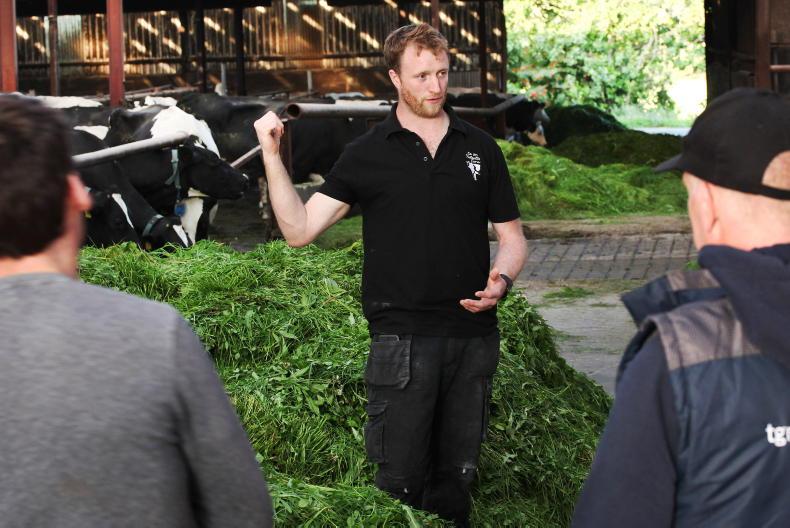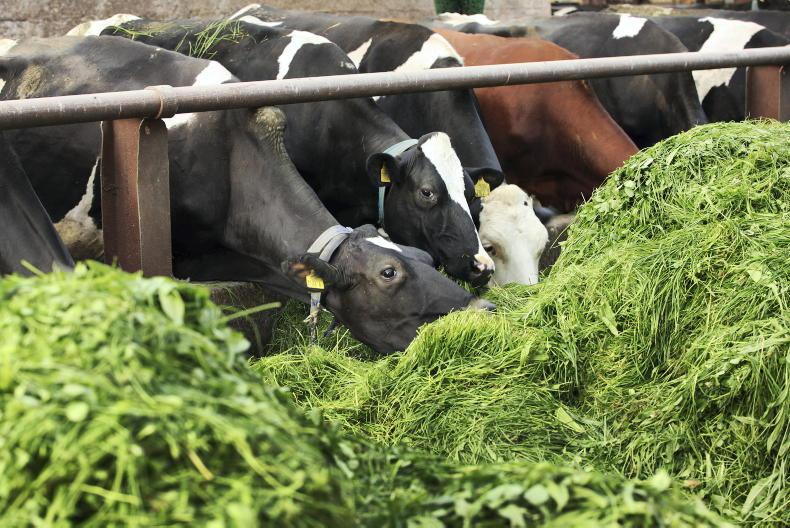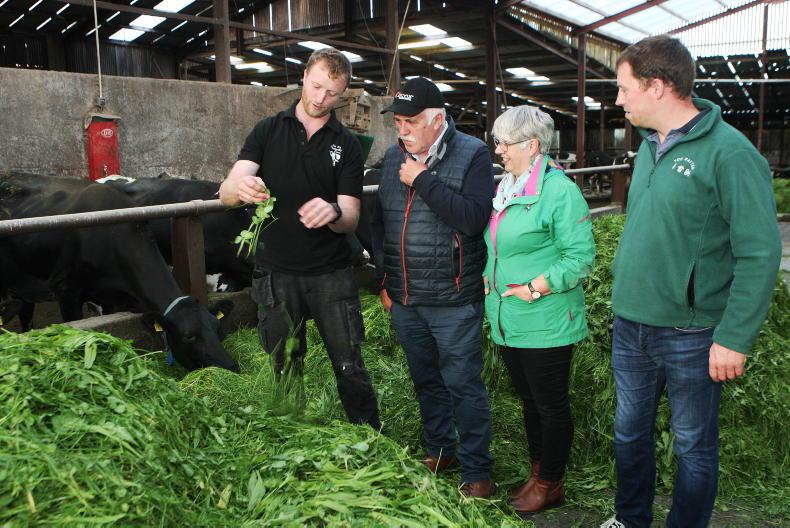Farm facts
250 dairy cows.Annual yield 8,500 litres/cow.4.15% butterfat and 3.45% protein.85% of cows calving September/October.350 acres farmed.Zero grazing and multispecies swards.Multispecies swards have grown in popularity in recent years and, in most instances, they have had a positive impact on growing fodder without chemical fertiliser.
In 2021, William Chestnutt introduced such swards on his dairy farm outside Portrush. In the two years since then, he has been scaling up the area sown out in multispecies swards.
Other changes have been implemented to make the farming system more resilient against rising input costs, all of which were outlined during a recent farm walk organised by the Growing Innovation Network (Grow IN).
This new network of NI farmers works together to share ideas and knowledge around soil health and sustainable farming.
William farms with his wife, Allison, and parents, James and Ruth, on 350 acres of owned and rented land, most of which is laid out in grass. The farm runs 250 dairy cows, yielding 8,500 litres annually at 4.15% butterfat and 3.45% protein.
Crossbreeding
Prior to 2018, the herd consisted of Holstein breeding. Since then, William has moved to a crossbreeding programme.
He uses a three-way mix of Holstein, Montbéliarde and Viking Red genetics, with all cows served to AI. Few animals need more than a second service.
Cows are predominately autumn calving, with 85% of the herd calving from early September to late October. The remaining 15% of cows calve from November to February.
“The change in cow type was driven by two factors. We found that Holstein cows just do not have the longevity to last in our system,” said William.

William Chesnutt explaining his experience from being part of the AFBI silage-check and Growing Innovation Network programme during an open evening on his farm near Portrush, Co Antrim. \ Houston Green
“Having a high culling rate was costing a lot of money. Rearing heifers for replacements is expensive and we were having to keep more than I would have liked.”
The other factor behind the change in breeding policy was cow fertility. Getting cows back in-calf was a challenge and cows were slipping out of the target calving period.
“I like having a big block of cows calving in September and October. It makes things easier to manage in terms of feeding and breeding through the winter.
“It also means our heifer calves are born from our most fertile cows and fit into the system when calved at 24 months of age.”
Reducing inputs
William has been looking to reduce the reliance on purchased inputs for some time, starting with chemical nitrogen.
Last year, the farm averaged 86kg/ha (69 units/acre) of nitrogen across all grassland, most of which was targeted to silage ground. Swards on the grazing platform are primarily fertilised with slurry applied by a dribble bar.

Cows yield 8,500 litres annually and 85% of the herd calves in September and November. \ Houston Green
“We operate a zero grazing system to utilise fresh grass, rather than allowing cows out to graze by day and night. Grass is harvested daily and gives far higher utilisation from each field. It also means I can keep on top of grass quality, as fields are cut when grass is at the right stage.
“As cows are kept inside, there is plenty of slurry to spread throughout the year. Zero grazing starts around April, once cows are scanned in-calf and daily yields are back to 30 litres.”
Soil fertility
William is a great believer in soil health and along with targeted use of organic manures, he applies foliar products high in trace minerals, such as Sea-90 and other soil bio-stimulants, such as humates.
“Fertile soil is more than just getting pH, or P and K right. To get healthy soils, you have to feed them properly. Along with soil testing, I take soil cores to measure soil health.
"If there are cores with little sign of earthworms or organic matter, I use a soil conditioner product to stimulate soil biology.”
Building diverse grass swards
In spring 2021, William stitched a six-species mix of ryegrass, white and red clover, plus plantain and chicory into a four-acre sward that was in need of rejuvenating.
The old sward was being zero-grazed and the new mix was drilled after cutting without burning off.
It was a successful introduction to multi-species swards, encouraging William to try and replicate the process the following year.
However, in 2022, the timings for reseeding were different and, as a result, the new sward was less successful in terms of establishment.
“Last year, I went later in June, as it was extremely dry. The lack of soil moisture meant the new sward was slow to establish. It was drilled using the same machine at 14kg/acre, then rolled, but it just wasn’t the same.”
Taking the plunge
The setback has not deterred William and, in late August, he drilled 36 acres of multi-species swards on land that produced whole-crop silage this summer.
On this occasion, the field was ploughed to leave a clean seedbed after the whole crop, giving the new sward every chance to grow.
The plan is to use the 36 acres for zero grazing. The regular cutting practice appears to be having a positive effect on weed control, as weeds struggle to compete with clovers and ryegrass.
“I like the idea of what the mixed swards do for soil biology. They are deeper rooting plants, so they open the soil more and help drainage and aeration.
“A diverse sward is a good thing. Some grasses grow better in spring than others and the same goes with summer and autumn growth.
“There is also an element of drought tolerance, although that’s not a problem we tend to have on our farm.”
Silage
So far, the multispecies swards have been confined to growing on land used for zero grazing, although there are plans to trial them on silage ground.

“I like the idea of what the mixed swards do for soil biology. They are deeper rooting plants, so they open the soil more and help drainage and aeration" - William Chestnutt. \ Houston Green
“Getting the silage wilted properly will be the challenge with the multispecies swards, as they are low in dry matter. You can see that from zero grazing.
“There is a lot of moisture in the forage when it is fed out. Wilting for silage will be tricky, especially in a year like this one, in terms of weather. But I think I will give it a try and see.”
Read more
Tips to prevent pneumonia in suckler weanlings at housing
Dairy Management: how to manage extra grass
Farm facts
250 dairy cows.Annual yield 8,500 litres/cow.4.15% butterfat and 3.45% protein.85% of cows calving September/October.350 acres farmed.Zero grazing and multispecies swards.Multispecies swards have grown in popularity in recent years and, in most instances, they have had a positive impact on growing fodder without chemical fertiliser.
In 2021, William Chestnutt introduced such swards on his dairy farm outside Portrush. In the two years since then, he has been scaling up the area sown out in multispecies swards.
Other changes have been implemented to make the farming system more resilient against rising input costs, all of which were outlined during a recent farm walk organised by the Growing Innovation Network (Grow IN).
This new network of NI farmers works together to share ideas and knowledge around soil health and sustainable farming.
William farms with his wife, Allison, and parents, James and Ruth, on 350 acres of owned and rented land, most of which is laid out in grass. The farm runs 250 dairy cows, yielding 8,500 litres annually at 4.15% butterfat and 3.45% protein.
Crossbreeding
Prior to 2018, the herd consisted of Holstein breeding. Since then, William has moved to a crossbreeding programme.
He uses a three-way mix of Holstein, Montbéliarde and Viking Red genetics, with all cows served to AI. Few animals need more than a second service.
Cows are predominately autumn calving, with 85% of the herd calving from early September to late October. The remaining 15% of cows calve from November to February.
“The change in cow type was driven by two factors. We found that Holstein cows just do not have the longevity to last in our system,” said William.

William Chesnutt explaining his experience from being part of the AFBI silage-check and Growing Innovation Network programme during an open evening on his farm near Portrush, Co Antrim. \ Houston Green
“Having a high culling rate was costing a lot of money. Rearing heifers for replacements is expensive and we were having to keep more than I would have liked.”
The other factor behind the change in breeding policy was cow fertility. Getting cows back in-calf was a challenge and cows were slipping out of the target calving period.
“I like having a big block of cows calving in September and October. It makes things easier to manage in terms of feeding and breeding through the winter.
“It also means our heifer calves are born from our most fertile cows and fit into the system when calved at 24 months of age.”
Reducing inputs
William has been looking to reduce the reliance on purchased inputs for some time, starting with chemical nitrogen.
Last year, the farm averaged 86kg/ha (69 units/acre) of nitrogen across all grassland, most of which was targeted to silage ground. Swards on the grazing platform are primarily fertilised with slurry applied by a dribble bar.

Cows yield 8,500 litres annually and 85% of the herd calves in September and November. \ Houston Green
“We operate a zero grazing system to utilise fresh grass, rather than allowing cows out to graze by day and night. Grass is harvested daily and gives far higher utilisation from each field. It also means I can keep on top of grass quality, as fields are cut when grass is at the right stage.
“As cows are kept inside, there is plenty of slurry to spread throughout the year. Zero grazing starts around April, once cows are scanned in-calf and daily yields are back to 30 litres.”
Soil fertility
William is a great believer in soil health and along with targeted use of organic manures, he applies foliar products high in trace minerals, such as Sea-90 and other soil bio-stimulants, such as humates.
“Fertile soil is more than just getting pH, or P and K right. To get healthy soils, you have to feed them properly. Along with soil testing, I take soil cores to measure soil health.
"If there are cores with little sign of earthworms or organic matter, I use a soil conditioner product to stimulate soil biology.”
Building diverse grass swards
In spring 2021, William stitched a six-species mix of ryegrass, white and red clover, plus plantain and chicory into a four-acre sward that was in need of rejuvenating.
The old sward was being zero-grazed and the new mix was drilled after cutting without burning off.
It was a successful introduction to multi-species swards, encouraging William to try and replicate the process the following year.
However, in 2022, the timings for reseeding were different and, as a result, the new sward was less successful in terms of establishment.
“Last year, I went later in June, as it was extremely dry. The lack of soil moisture meant the new sward was slow to establish. It was drilled using the same machine at 14kg/acre, then rolled, but it just wasn’t the same.”
Taking the plunge
The setback has not deterred William and, in late August, he drilled 36 acres of multi-species swards on land that produced whole-crop silage this summer.
On this occasion, the field was ploughed to leave a clean seedbed after the whole crop, giving the new sward every chance to grow.
The plan is to use the 36 acres for zero grazing. The regular cutting practice appears to be having a positive effect on weed control, as weeds struggle to compete with clovers and ryegrass.
“I like the idea of what the mixed swards do for soil biology. They are deeper rooting plants, so they open the soil more and help drainage and aeration.
“A diverse sward is a good thing. Some grasses grow better in spring than others and the same goes with summer and autumn growth.
“There is also an element of drought tolerance, although that’s not a problem we tend to have on our farm.”
Silage
So far, the multispecies swards have been confined to growing on land used for zero grazing, although there are plans to trial them on silage ground.

“I like the idea of what the mixed swards do for soil biology. They are deeper rooting plants, so they open the soil more and help drainage and aeration" - William Chestnutt. \ Houston Green
“Getting the silage wilted properly will be the challenge with the multispecies swards, as they are low in dry matter. You can see that from zero grazing.
“There is a lot of moisture in the forage when it is fed out. Wilting for silage will be tricky, especially in a year like this one, in terms of weather. But I think I will give it a try and see.”
Read more
Tips to prevent pneumonia in suckler weanlings at housing
Dairy Management: how to manage extra grass









 This is a subscriber-only article
This is a subscriber-only article









SHARING OPTIONS: